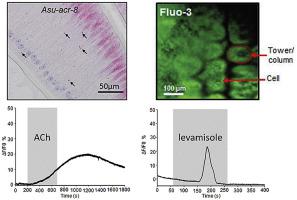International Journal for Parasitology: Drugs and Drug Resistance ( IF 4.1 ) Pub Date : 2020-04-25 , DOI: 10.1016/j.ijpddr.2020.04.002 Mark McHugh 1 , Paul Williams 2 , Saurabh Verma 2 , Jo Anne Powell-Coffman 1 , Alan P Robertson 2 , Richard J Martin 2

|
Cholinergic agonists, like levamisole, are a major class of anthelmintic drugs that are known to act selectively on nicotinic acetylcholine receptors (nAChRs) on the somatic muscle and nerves of nematode parasites to produce their contraction and spastic paralysis. Previous studies have suggested that in addition to the nAChRs found on muscle and nerves, there are nAChRs on non-excitable tissues of nematode parasites. We looked for evidence of nAChRs expression in the cells of the intestine of the large pig nematode, Ascaris suum, using RT-PCR and RNAscope in situ hybridization and detected mRNA of nAChR subunits in the cells. These subunits include components of the putative levamisole receptor in A. suum muscle: Asu-unc-38, Asu-unc-29, Asu-unc-63 and Asu-acr-8. Relative expression of these mRNAs in A. suum intestine was quantified by qPCR. We also looked for and found expression of G protein-linked acetylcholine receptors (Asu-gar-1). We used Fluo-3 AM to detect intracellular calcium changes in response to receptor activation by acetylcholine (as a non-selective agonist) and levamisole (as an L-type nAChR agonist) to look for evidence of functioning nAChRs in the intestine. We found that both acetylcholine and levamisole elicited increases in intracellular calcium but their signal profiles in isolated intestinal tissues were different, suggesting activation of different receptor sets. The levamisole responses were blocked by mecamylamine, a nicotinic receptor antagonist in A. suum, indicating the activation of intestinal nAChRs rather than G protein-linked acetylcholine receptors (GARs) by levamisole. The detection of nAChRs in cells of the intestine, in addition to those on muscles and nerves, reveals another site of action of the cholinergic anthelmintics and a site that may contribute to the synergistic interactions of cholinergic anthelmintics with other anthelmintics that affect the intestine (Cry5B).
中文翻译:

猪蛔虫肠细胞上的胆碱能受体和左旋咪唑对 nAChR 的激活。
胆碱能激动剂,如左旋咪唑,是一类主要的驱虫药,已知其选择性地作用于线虫寄生虫躯体肌肉和神经上的烟碱乙酰胆碱受体(nAChR),产生收缩和痉挛性麻痹。先前的研究表明,除了在肌肉和神经上发现的nAChR之外,线虫寄生虫的非兴奋组织上也存在nAChR。我们使用 RT-PCR 和 RNAscope原位杂交寻找大型猪线虫肠道细胞中 nAChR 表达的证据,并检测细胞中 nAChR 亚基的 mRNA。这些亚基包括猪蛔虫肌肉中推定的左旋咪唑受体的成分: Asu-unc-38、Asu-unc-29、Asu-unc-63和Asu-acr-8 。通过 qPCR 定量这些 mRNA 在A. suum肠中的相对表达。我们还寻找并发现了 G 蛋白连接的乙酰胆碱受体 ( Asu-gar-1 ) 的表达。我们使用 Fluo-3 AM 检测乙酰胆碱(作为非选择性激动剂)和左旋咪唑(作为 L 型 nAChR 激动剂)受体激活时细胞内钙的变化,以寻找 nAChR 在肠道中起作用的证据。我们发现乙酰胆碱和左旋咪唑都会引起细胞内钙的增加,但它们在分离的肠道组织中的信号谱不同,表明激活了不同的受体组。左旋咪唑反应被猪曲霉中的烟碱受体拮抗剂美加明阻断,表明左旋咪唑激活了肠道 nAChR,而不是 G 蛋白连接的乙酰胆碱受体 (GAR) 。除了肌肉和神经上的细胞外,肠道细胞中 nAChR 的检测揭示了胆碱能驱虫药的另一个作用位点,以及可能有助于胆碱能驱虫药与影响肠道的其他驱虫药产生协同相互作用的位点 (Cry5B) )。











































 京公网安备 11010802027423号
京公网安备 11010802027423号